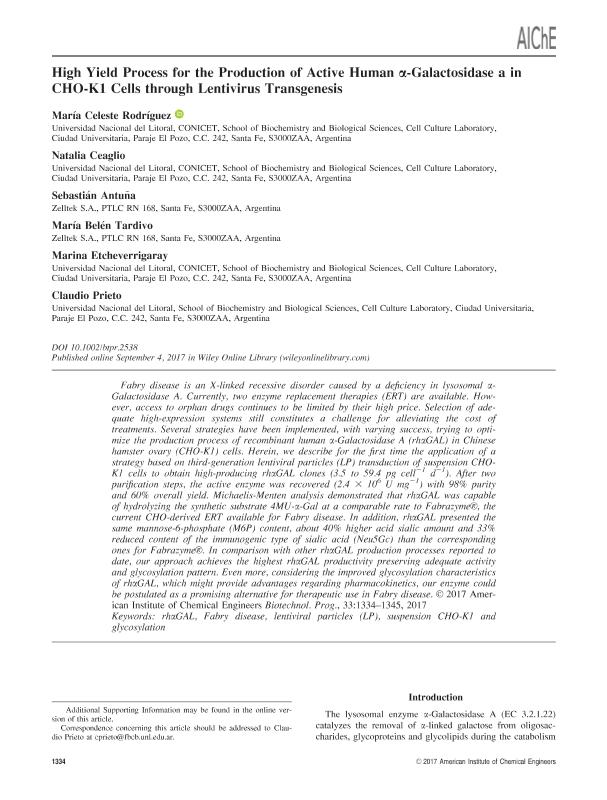Mostrar el registro sencillo del ítem
dc.contributor.author
Rodríguez, María Celeste

dc.contributor.author
Ceaglio, Natalia Analia

dc.contributor.author
Antuña, Sebastián

dc.contributor.author
Tardivo, María Belén
dc.contributor.author
Etcheverrigaray, Marina

dc.contributor.author
Prieto, Claudio

dc.date.available
2018-01-17T18:38:51Z
dc.date.issued
2017-08
dc.identifier.citation
Rodríguez, María Celeste; Tardivo, María Belén; Ceaglio, Natalia Analia; Antuña, Sebastián; Etcheverrigaray, Marina; Prieto, Claudio; et al.; High yield process for the production of active human alpha-Galactosidase A in CHO-K1 cells through lentivirus transgenesis; American Chemical Society; Biotechnology Progress; 33; 5; 8-2017; 1334-1345
dc.identifier.issn
8756-7938
dc.identifier.uri
http://hdl.handle.net/11336/33653
dc.description.abstract
Fabry disease is an X-linked recessive disorder caused by a deficiency in lysosomal α-Galactosidase A. Currently, two enzyme replacement therapies (ERT) are available. However, access to orphan drugs continues to be limited by their high price. Selection of adequate high-expression systems still constitutes a challenge for alleviating the cost of treatments. Several strategies have been implemented, with varying success, trying to optimize the production process of recombinant human α-Galactosidase A (rhαGAL) in Chinese hamster ovary (CHO-K1) cells. Herein, we describe for the first time the application of a strategy based on third-generation lentiviral particles (LP) transduction of suspension CHO-K1 cells to obtain high-producing rhαGAL clones (3.5 to 59.4 pg.cell-1.d-1). After two purification steps, the active enzyme was recovered (2.4 x 106 U.mg-1) with 98% purity and 60% overall yield. Michaelis-Menten analysis demonstrated that rhαGAL was capable of hydrolyzing the synthetic substrate 4MU-α-Gal at a comparable rate to Fabrazyme®, the current CHO-derived ERT available for Fabry disease. In addition, rhαGAL presented the same mannose-6-phosphate (M6P) content, about 40% higher acid sialic amount and 33% reduced content of the immunogenic type of sialic acid (Neu5Gc) than the corresponding ones for Fabrazyme®. In comparison with other rhαGAL production processes reported to date, our approach achieves the highest rhαGAL productivity preserving adequate activity and glycosylation pattern. Even more, considering the improved glycosylation characteristics of rhαGAL, which might provide advantages regarding pharmacokinetics, our enzyme could be postulated as a promising alternative for therapeutic use in Fabry disease.
dc.format
application/pdf
dc.language.iso
eng
dc.publisher
American Chemical Society

dc.rights
info:eu-repo/semantics/openAccess
dc.rights.uri
https://creativecommons.org/licenses/by-nc-sa/2.5/ar/
dc.subject
Rhalphagal
dc.subject
Fabry Disease
dc.subject
Lentiviral Particles (Lp)
dc.subject
Suspension Cho-K1
dc.subject
Glycosylation
dc.subject.classification
Otras Biotecnologías de la Salud

dc.subject.classification
Biotecnología de la Salud

dc.subject.classification
CIENCIAS MÉDICAS Y DE LA SALUD

dc.title
High yield process for the production of active human alpha-Galactosidase A in CHO-K1 cells through lentivirus transgenesis
dc.type
info:eu-repo/semantics/article
dc.type
info:ar-repo/semantics/artículo
dc.type
info:eu-repo/semantics/publishedVersion
dc.date.updated
2018-01-02T14:03:58Z
dc.journal.volume
33
dc.journal.number
5
dc.journal.pagination
1334-1345
dc.journal.pais
Estados Unidos

dc.journal.ciudad
Washington
dc.description.fil
Fil: Rodríguez, María Celeste. Universidad Nacional del Litoral. Facultad de Bioquímica y Ciencias Biológicas. Laboratorio de Cultivos Celulares; Argentina. Consejo Nacional de Investigaciones Científicas y Técnicas. Centro Científico Tecnológico Conicet - Santa Fe; Argentina
dc.description.fil
Fil: Ceaglio, Natalia Analia. Universidad Nacional del Litoral. Facultad de Bioquímica y Ciencias Biológicas. Laboratorio de Cultivos Celulares; Argentina. Consejo Nacional de Investigaciones Científicas y Técnicas. Centro Científico Tecnológico Conicet - Santa Fe; Argentina
dc.description.fil
Fil: Antuña, Sebastián. Zeltek S.A.; Argentina
dc.description.fil
Fil: Tardivo, María Belén. Zeltek S.A.; Argentina
dc.description.fil
Fil: Etcheverrigaray, Marina. Universidad Nacional del Litoral. Facultad de Bioquímica y Ciencias Biológicas. Laboratorio de Cultivos Celulares; Argentina. Consejo Nacional de Investigaciones Científicas y Técnicas. Centro Científico Tecnológico Conicet - Santa Fe; Argentina
dc.description.fil
Fil: Prieto, Claudio. Universidad Nacional del Litoral. Facultad de Bioquímica y Ciencias Biológicas. Laboratorio de Cultivos Celulares; Argentina
dc.journal.title
Biotechnology Progress

dc.relation.alternativeid
info:eu-repo/semantics/altIdentifier/doi/http://dx.doi.org/10.1002/btpr.2538
dc.relation.alternativeid
info:eu-repo/semantics/altIdentifier/url/http://onlinelibrary.wiley.com/doi/10.1002/btpr.2538/abstract;jsessionid=8482CDD1AA5568B4B29792926906BA84.f01t02
Archivos asociados
